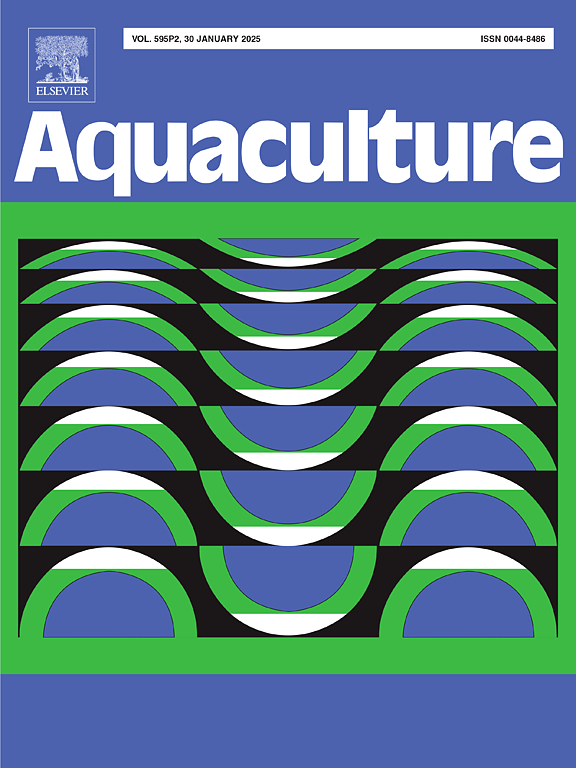循环养殖系统中代谢率和特定动态作用的评价:放养密度和摄食水平对梭鲈的影响
IF 3.9
1区 农林科学
Q1 FISHERIES
引用次数: 0
摘要
生物能量建模在水产养殖、优化营养、生长预测、畜牧业和遗传管理方面发挥着至关重要的作用。动物代谢率(MR)的估计,传统上是在封闭的呼吸室中进行的,是这些模型的一个基本方面。本研究提出了一种在循循环养殖系统(RAS)中直接测量鱼类MR、常规代谢率(RMR)、餐后峰值代谢率(PMR)和特定动态作用(SDA)参数(包括SDA系数(CSDA))的新方法。此外,该研究还评估了鱼类大小、放养密度和摄食水平对这些代谢指标的影响。将3510只barramundi (Lates calcarifer, 51.2 g)放在27个RAS水箱中(1 m3, 30.0 °C海水),每10 min溶解氧水平56 天,模拟代谢参数。鱼的MR范围为14.5至112.8 mg O2 Fish - 1 h - 1,遵循每日正弦模式。PMR适应能力模型(PMR = 2.18 × 体重(BW) 0.71, R2 = 0.70,n = 810),而RMR跟着一个指数模型(RMR = 6.31 × exp。(0.01 × BW), R2 = 0.87,n = 148)。SDA参数仍主要由放养密度影响或喂养率(P 祝辞 0.05),与time-to-peak = 8.8 - -10.7 h,总SDA = 持续时间22.1 - -22.6 h, SDA事实 = 范围2.0 - -2.9,CSDA = 14.8 - -16.4 %。虽然这种基于ras的方法与封闭室呼吸法的精度不匹配,但结果与先前的发现密切一致。因此,这种方法为商业水产养殖中表型代谢变异提供了一种可扩展的工具。本文章由计算机程序翻译,如有差异,请以英文原文为准。
Evaluating metabolic rate and specific dynamic action in recirculating aquaculture systems: Influence of stocking density and feeding level in barramundi (Lates calcarifer)
Bioenergetic modelling plays a crucial role in aquaculture, optimizing nutrition, growth prediction, husbandry, and genetic management. The estimation of animal metabolic rate (MR), traditionally conducted in closed respirometric chambers, is a fundamental aspect of these models. This study presents a novel method for directly measuring fish MR, routine metabolic rate (RMR), postprandial peak metabolic rate (PMR), and specific dynamic action (SDA) parameters including SDA coefficient (CSDA) within a recirculating aquaculture system (RAS). Additionally, the study evaluates the effects of fish size, stocking density, and feeding levels on these metabolic metrics. Using 3510 barramundi (Lates calcarifer, 51.2 g) housed in 27 RAS tanks (1 m3, 30.0 °C seawater), dissolved oxygen levels every 10 min for 56 days to model metabolic parameters. Fish MR ranged from 14.5 to 112.8 mg O2 fish−1 h−1, following a daily sinusoidal pattern. PMR fit a power model (PMR = 2.18 × body weight [BW]0.71, R2 = 0.70, n = 810), while RMR followed an exponential model (RMR = 6.31 × exp. (0.01 × BW), R2 = 0.87, n = 148). SDA parameters remained largely unaffected by stocking density or feeding rate (P > 0.05), with time-to-peak = 8.8–10.7 h, total SDA duration = 22.1–22.6 h, SDA factual scope = 2.0–2.9, and CSDA = 14.8–16.4 %. Although this RAS-based methodology does not match the precision of closed-chamber respirometry, the results closely align with previous findings. This approach therefore provides a scalable tool for phenotyping metabolic variations in commercial aquaculture.
求助全文
通过发布文献求助,成功后即可免费获取论文全文。
去求助
来源期刊

Aquaculture
农林科学-海洋与淡水生物学
CiteScore
8.60
自引率
17.80%
发文量
1246
审稿时长
56 days
期刊介绍:
Aquaculture is an international journal for the exploration, improvement and management of all freshwater and marine food resources. It publishes novel and innovative research of world-wide interest on farming of aquatic organisms, which includes finfish, mollusks, crustaceans and aquatic plants for human consumption. Research on ornamentals is not a focus of the Journal. Aquaculture only publishes papers with a clear relevance to improving aquaculture practices or a potential application.
 求助内容:
求助内容: 应助结果提醒方式:
应助结果提醒方式:


